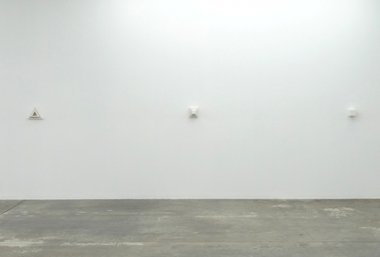John Hurrell – 15 August, 2013
These are indisputably intriguing objects, but precisely why is extremely hard to say. As little sculptural reliefs their use of rhythmical repetition is engaging, so that the elemental contours of geometric shape are accentuated. Plus there is the humour of calling them ‘paintings', where instead of adding paint the artist simply adds another stretcher. Brancusi and Andre revisited, albeit cute this time.
In this second part of the Julian Dashper Untitled exhibition at Lett, the first installation of two large works has been replaced by a second of twelve small ones - again all late paintings.
Distributed along three long walls, some of these white primed canvases are very small. Eleven of the twelve are layered, extending out from the wall towards the centre of the room; the butting together of stretched canvases occurring along a vertical plane - like sponge cakes or modernist architecture.
These are austere, very simple stacks projecting out horizontally, with four vertical strata at max. Two with triangles, Untitled (2006), 2006, and squares, Untitled (The End of All Obsessive Behaviour) Part 3, 2002, have the canvases flipped over so it is the backs we see, their largest ‘front’ surfaces flat on the gallery wall and the outermost forms progressively diminishing in size. The titles are an acknowledgement of art world careerist claustrophobia.
Visually, these are indisputably intriguing objects - but precisely why is extremely hard to say. As little sculptural reliefs their use of rhythmical repetition is engaging, so that the elemental contours of geometric shape are accentuated. Plus there is the humour of calling them ‘paintings’, where instead of adding paint the artist simply adds another stretcher. Brancusi and Andre revisited, albeit cute this time.
As a devisor of painting supports transmuted into natty wall sculpture, Dashper was shrewd in not making them too big, but always portable. The proportion of the thickness at the side with the width and height at the front is crucial. The most successful ones are chunky, compact and squat, as if educational mathematical aids in a primary school, constructed with readymades from an art supply store.
Dashper’s interest in stacking these works outwards - away from the wall - is an acknowledgement of the modernist tendency to work in series, where the continuous process of art production (as thematic exploration) establishes a historical context for each painting through which each predecessor is replaced. The most recent endeavour is the most visible, hiding the others underneath. The result is a meditation on the procedures of sequential research, a contemplation on consistency and focus.
John Hurrell

 Advertising in this column
Advertising in this column Two Rooms presents a program of residencies and projects
Two Rooms presents a program of residencies and projects



This Discussion has 0 comments.
Comment
Participate
Register to Participate.
Sign in
Sign in to an existing account.